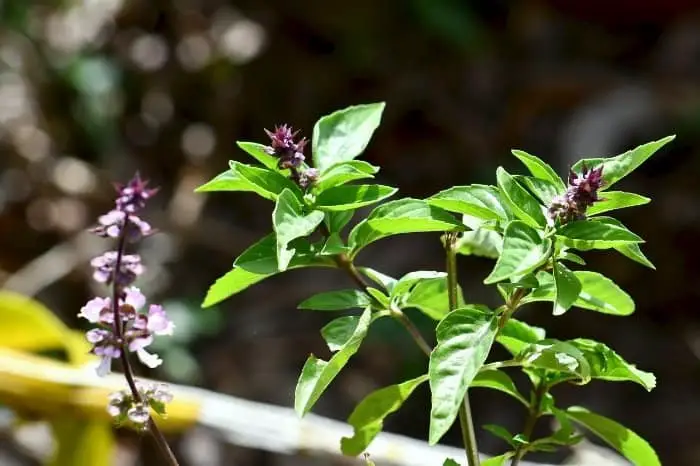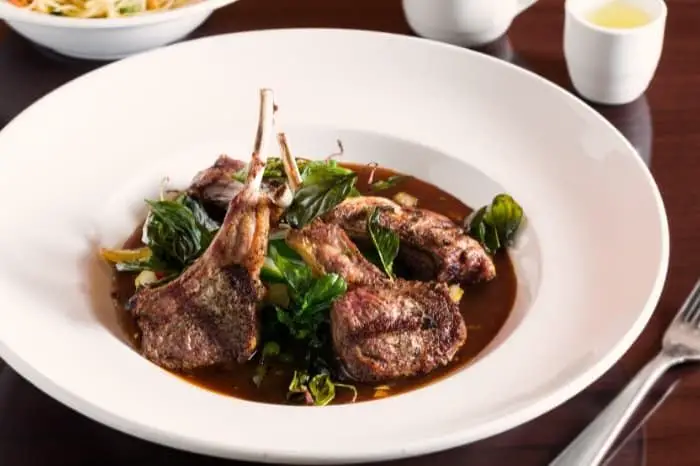Last Updated on October 29, 2022
We have many varieties of basil. There is the common or regular basil, Thai basil, lime basil, Cinnamon basil, Lemon basil, and others. In this article, we will be discussing the difference between Thai basil and regular basil.
Generally, it has been estimated that there are over 100 varieties of basil and all types of basil are members of the mint family. Both are from the same family. However, we have some slight differences between these two basil varieties.
We have listed here what makes them unique. We’ve also listed what and how you can use these two basil varieties as well as how they can be substituted. So continue reading to learn more about the difference between Thai basil and regular basil.
What Is Thai Basil?
Thai basil is a type of basil variety native to Southeast Asia and it’s also known as chi neang vorng. It is a popular ingredient for cooking and it’s commonly used amongst Southern Asians and Chinese. The chi neang vorng leaves are so versatile, therefore, used in many recipes.
Chi neang vorng is a variety of basil that has a touch or feel of anise or black licorice flavor. It offers that pleasant taste or savory, spicy, anise-like note to so many Southeast Asia and Chinese cooking.

This variety is very common in Southeast Asian cuisines, Cambodia, Lao, Vietnamese dishes including Thai recipes. Chi neang vorng has this definite or distinct flavor with that strong black note and a bit of spice on the finishing touch.
The Regular Sweet Italian Basils
The most common or regular basil is referred to as sweet basil, Genovese basil, or Italian sweet basil. It is scientifically known as Ocimum basilicum. The tasty green leaves of Italian sweet basil works well with so many dishes. Sweet Italian basil is very common in American and European cooking.
The regular Italian sweet basil is widely used in American and European cuisines. The leaves are bright green with a green stem.
Compared to chi neang vorng leaves, the Italian sweet basil leaves are larger. Then sweet variety has a milder flavor than Thai basil and it has a hint of black pepper and subtle anise.
Difference Between Thai Basil And Regular Basil: Basil vs Thai Basil
So what is the difference between Thai basil and regular basil? Let’s find out.
1. Taste
The Italian sweet basil has a distinct and more robust taste. The taste has a mix of anise, peppery, and sweet flavor. There are chances you must have tasted the sweet basil in a large variety of dishes.
Chi neang vorng on the other hand has a milder flavor. It also has an extra aroma of licorice together with a spicy feeling.
8 Basil Herb Seed Pack – Cinnamon, Dark Opal, Genovese, Holy, Italian, Lemon, Sweet, Thai Basil
2. Physical Appearance
It’s pretty easy differentiating Thai basil and the regular sweet basil from their appearance. Let’s take a look at the leaves, stems, and flowers for their physical appearance.
-
Leaves
The leaves of the Italian sweet basil are bigger and have an oval curly down leaf.
Contrastingly, chi neang vorng leaves are thinner, narrower, more prolonged, and often straight.
Also, when you rub the sweet Italian basil leaves with your palm, it becomes less and will generate an intense aroma. Thai basil on the other hand does not have this feature.
-
Stem
The stem of sweet Italian basil is green while the stem of Thai basil is purple. Also, it has a hairy stem and sweet basil has a smooth stem.
These two basil varieties tend to grow rigid and can become woody at the end of their life.
-
Flowers
The flower sweet basil generates at the end of their life is a small white flower. Chi neang vorng flower generates more colorful purple or pink color.
They both present a small flower and the same shape.
3. Culinary Use
These two basil varieties differ significantly when it comes to culinary use.
As we mentioned, chi neang vorng is commonly used in East Asia. This basil variety can be used in so many dishes. Some popular Asian dishes are Thai basil chicken, Thai larb or meat salad, pho, and Thai style-curry.
Additionally, chi neang vorng seeds are often used to make tasty cold drinks. They can also be used as dessert ice cream. They are often added to ice cream because of their ability to reduce water crystals in the mixture.
The regular sweet Italian basil is widely used in American cooking and European cooking. It is a staple of Mediterranean cuisine especially Italian.
There are countless dishes that this regular sweet basil can make. You can add them to beans, eggs, chickens, fish, soups, pasta, cheeses, and salad. They can even be used as toppings for pizza.
-
Temperature Effect During Cooking
When it comes to their temperature behavior during cooking, there is a major difference between these two varieties of basil.
The regular sweet basil must always be added as a finishing touch while cooking. This is because sweet basil leaves are not as sturdy as the other basil. Hence, it can’t tolerate so much heat.
Thai basil on the other hand can withstand heat. Hence, you can add it at the very beginning of your cooking together with other ingredients so their flavor can be released gradually.

Can They Be Substituted With Each Other?
The answer is yes and no and it depends on the recipe.
-
-
When it comes to some recipes, you can substitute sweet basil if that’s all you have. However, if you’re making a special recipe like the traditional Southeast Asian dish like curry, pho, or spring roll, it’s necessary you choose the original flavor.
-
Substituting Thai basil for sweet basil may not really go well. This is because of the pungent anise flavor of Thai basil that is incomparable to the regular sweet one when it comes to the flavor.
-
FAQ’s
Are Thai basil and Italian basil the same thing?
Thai basil is not really the same as Italian basil. In fact, it's a different species altogether, although it has similar characteristics.
Can you substitute regular basil for Thai basil?
Yes, you can substitute regular basil for Thai basil. They have the same properties, but the leaves are a bit thinner. You’ll need to cut your Thai basil into smaller pieces and dry it out before using it.
The two can be used interchangeably in most recipes, but it's best to buy both when you can.
How do I identify Thai basil?
Thai basil (Ocimum basilicum) is one of the most popular herbs in the world. It's a fragrant, pungent herb that looks like a cross between sweet basil and tarragon. Thai basil is often used in Thai cooking and can be found in many supermarkets, Asian grocery stores, and online. You'll know you've got it when you see the leaves arranged in a tight cluster, with their stems attached to the bottom.
It's also a great addition to Thai dishes, as it complements the sourness of Thai ingredients, such as lime or tamarind.
How do they look different?
Thai basil leaves are much smaller, and they grow in a bush rather than a tall stalk.
Can you substitute regular basil for Thai basil?
Yes, you can substitute regular basil for Thai basil. They have the same properties, but the leaves are a bit thinner. You’ll need to cut your Thai basil into smaller pieces and dry it out before using it.
The main thing that you have to keep in mind in terms of using Thai basil as a substitute is that it is spicier in flavor. Thai basil is less delicate than sweet basil and has a sharper, spicier flavor. So you do have token this in mind as you go about using it in your recipes.
What do you use Thai basil for?
Thai basil is one of the most popular herbs in Thai cooking, and it's widely used in Thai dishes. It's also one of the most versatile herbs you can use in your kitchen. Here are some of the ways to use Thai basil in your kitchen:
1. Thai basil is a must-have herb for Thai cuisine. You can add it to stir-fries, soups, curries, salads, and desserts. It's used in most Thai recipes, including green papaya salad, pad Thai, tom yum goong (Thai curry soup), and kung pao chicken.
2. Thai basil has a strong, fresh flavor and is an excellent addition to Thai dishes. Add Thai basil to chicken soup, Thai tom yum, and Thai noodle soup.
3. Thai basil is one of the most fragrant herbs. Use it in marinades, sauces, and salad dressings.
It does make a good pesto. It has a little bit more depth to it. I also think it's easier to find fresh than regular basil.
Difference Between Thai Basil And Regular Basil: Final Say
The two basil are popular and amazing ingredients used in many dishes.
Both basil varieties may come from the same family; there is still a significant difference between them.

Eunice is an enthusiastic gardener with a passion for growing beautiful flowers. She loves nothing more than spending time in her garden, tending to her plants and enjoying the outdoors. Eunice has been gardening for over 15 years and has developed a unique style of landscaping that is both practical and aesthetically pleasing. She is especially fond of growing roses and enjoys experimenting with different varieties and colors. Eunice takes great pride in her garden and often shares the fruits of her labor with friends and family. In her spare time, she enjoys reading gardening magazines and attending local horticulture events. Eunice is passionate about her hobby and is always eager to share her knowledge and experience with others.

